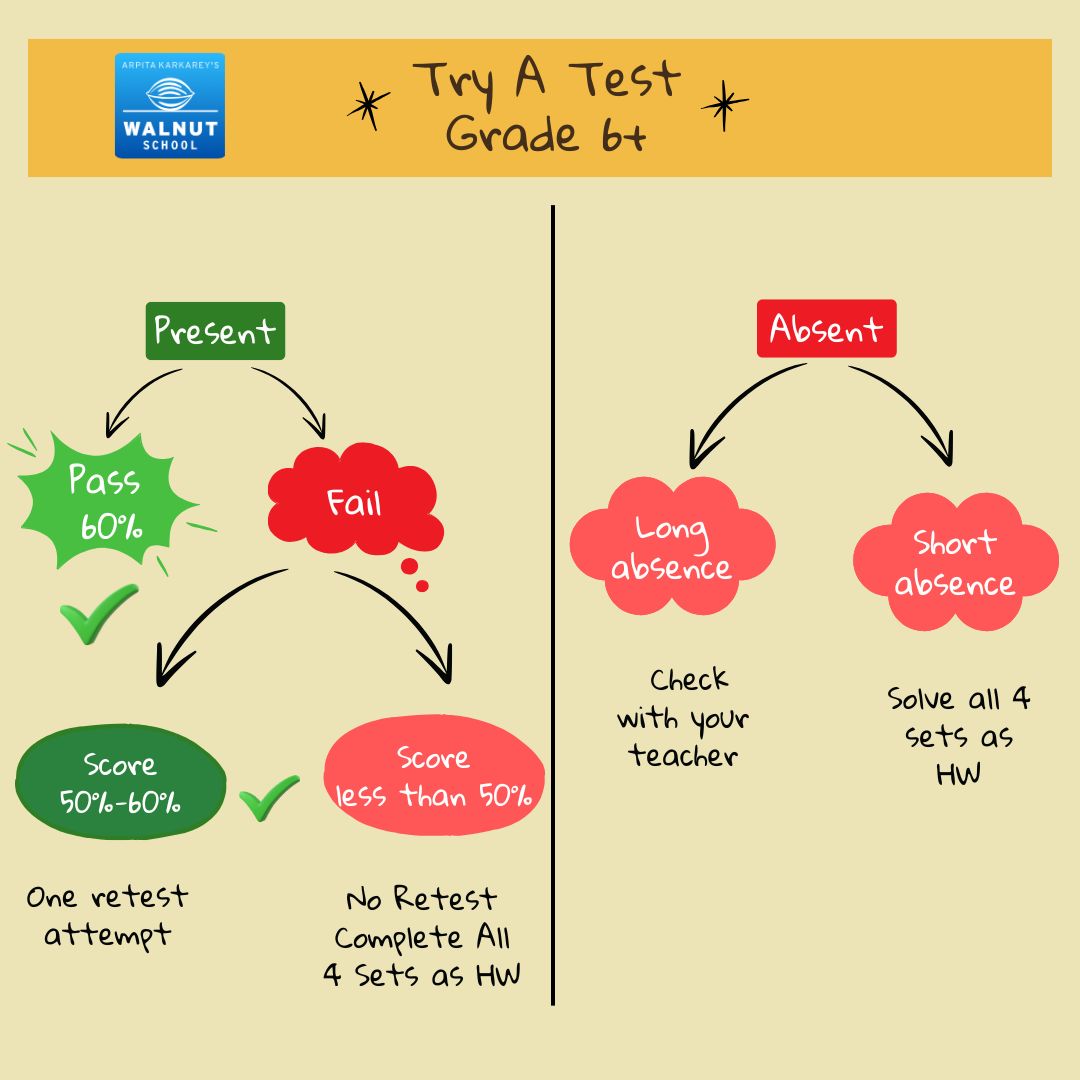Try a tests
Only for Secondary students
These are chapter-based tests for students of Std. 6 and beyond. They start in Mathematics in Std. 6 and once the Std. 10 curriculum starts, students have them in every subject, after every chapter. These are 15-mark written tests that take up half an hour. There are four sets of question papers so there is no copying. They have a minimum passing of 60%.
Retest Criteria
For students who score less than passing marks:
- Students scoring between 7.5 and 9 marks (50%–60%) are given only one chance for a retest for self-improvement.
- The retest happens in either the sports or activity classes. The teacher decides based on the timetable and other logistics etc.
- This retest can be from any of the four sets that the student has received. It will be decided on the spot, so students must prepare for all four sets.
- Students are expected to score 12 marks or more. No further retests will be conducted after this.
Low Score Penalty (Score less than 7.5)
- Students scoring less than 7.5 marks (below 50%) are not allowed a retest.
- These students have to write answers for all four Try-A-Test sets as homework.
- This homework has to be submitted to the teacher in school in 2 days after the TAT paper is returned back to them in school. Even Saturday, Sunday and holidays are considered to be part of this.
- If not submitted, the students will be detained from sports periods till they do. They may be given additional academic writing as well.
Absent Students
- Absent students miss the chance for both test and retest.
- They must submit all four sets along with the low-performing students.
- For long absences, check with your subject teacher as to what has to be done.
If the parent would like their child to opt out of the retest or low marks penalty, please send an email stating: "I OPT OUT OF THE RETEST / LOW MARKS PENALTY". We will not ask the child to take the retest or complete the penalty work for any Try-A-Test for the rest of the academic year.
Thank you for your cooperation and understanding as we work together to help students take ownership of their learning.

Benefits
- Build regular studying habits
- Helps teachers keep track of academic progress of each student
- Reduces stress of studying for larger portion tests
- Keeps students on their toes
.jpg)
Students are expected to go through the corrected Try - a - Test, write down the missing points in different - coloured ink on their answer sheet itself for those answers where full or maximum marks have not been gained, and then file the Try - a - Tests properly in the subject files.
Try-A-Test Subject Schedule
| Standard | MATH | SCI | SOC | ENG | MAR |
|---|---|---|---|---|---|
| Std. 6 | 7th syllabus | - | - | - | - |
| Std. 7 | 7th, 8th syllabus | - | - | - | - |
| Std. 8 | 8th, 9th syllabus | - | 10th syllabus | 10th syllabus | - |
| Std. 9 | 9th, 10th syllabus | 10th syllabus | 10th syllabus | 10th syllabus | 10th syllabus |
| Std. 10 | 10th syllabus | 10th syllabus | 10th syllabus | 10th syllabus | 10th syllabus |
Why are "Try-A-Tests" important?
- Smallest unit of study: Only one chapter at a time.
- Regular study habits: When each chapter is revised properly on completion, larger tests and portions are more manageable as they come up — unit tests, prelims, and ultimately, board exams.
- Study Material: Each student has access to 4 sets of 15-mark question papers. They get more material for practice and self-checking, with model answers provided too.
- Character building: Students have to prepare and appear for the tests. This requires them to manage their time, stay disciplined, and take ownership. No excuses — just action. If not, they face consequences like penalty tests and missing out on sports or activities. Real-life lessons, right?
All in all, these "Try-A-Tests" foster a culture of regularity, hard work, thorough preparation, and a drive for excellence. They teach students how to use time wisely, handle pressure constructively, and face challenges head-on.
With this approach, students not only improve academically but also grow in character. Tough outside, smart inside — that's what we're working towards, right?
.jpg)